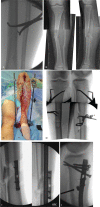Reduction techniques for intramedullary nailing of tibial shaft fractures: a comparative study
- PMID: 33937718
- PMCID: PMC8016605
- DOI: 10.1097/OI9.0000000000000095
Reduction techniques for intramedullary nailing of tibial shaft fractures: a comparative study
Abstract
Objectives: To assess the impact of various reduction techniques on postoperative alignment following intramedullary nail (IMN) fixation of tibial shaft fractures.
Design: Retrospective comparative study.
Setting: Level I trauma center.
Patients: Four hundred twenty-eight adult patients who underwent IMN fixation of a tibial shaft fracture between 2008 and 2017.
Intervention: IMN fixation with use of one or more of the following reduction techniques: manual reduction, traveling traction, percutaneous clamps, provisional plating, or blocking screws.
Main outcome measures: Immediate postoperative coronal and sagittal plane alignment, measured as deviation from anatomic axis (DFAA); coronal and sagittal plane malalignment (defined as DFAA >5° in either plane).
Results: Four hundred twenty-eight patients met inclusion criteria. Manual reduction (MR) alone was used in 11% of fractures, and adjunctive reduction aids were used for the remaining 89%. After controlling for age, BMI, and fracture location, the use of traveling traction (TT) with or without percutaneous clamping (PC) resulted in significantly improved coronal plane alignment compared to MR alone (TT: 3.4°, TT+PC: 3.2°, MR: 4.5°, P = .007 and P = .01, respectively). Using TT+PC resulted in the lowest rate of coronal plane malalignment (13% vs 39% with MR alone, P = .01), and using any adjunctive reduction technique resulted in decreased malalignment rates compared to MR (24% vs 39%, P = .02). No difference was observed in sagittal plane alignment between reduction techniques. Intraclass correlation coefficient (ICC) results indicated excellent intraobserver reliability on both planes (both ICC>0.85), good inter-observer reliability in the coronal plane (ICC = 0.7), and poor inter-observer reliability in the sagittal plane (ICC = 0.05).
Conclusions: The use of adjunctive reduction techniques during IMN fixation of tibia fractures is associated with a lower incidence of coronal plane malalignment when compared to manual reduction alone.
Level of evidence: Therapeutic Level III.
Keywords: alignment; blocking screw; intramedullary nail; manual reduction; percutaneous clamp; reduction technique; tibia fracture; traveling traction.
Copyright © 2021 The Authors. Published by Wolters Kluwer Health, Inc. on behalf of the Orthopaedic Trauma Association.
Conflict of interest statement
The authors have no conflicts of interest to disclose.
Figures

References
-
- Vallier HA, Cureton BA, Patterson BM. Randomized, prospective comparison of plate versus intramedullary nail fixation for distal tibia shaft fractures. J Orthop Trauma. 2011;25:736–741. - PubMed
-
- Avilucea FR, Triantafillou K, Whiting PS, et al. Suprapatellar intramedullary nail technique lowers rate of malalignment of distal tibia fractures. J Orthop Trauma. 2016;30:557–560. - PubMed
-
- Collinge CA, Beltran MJ, Dollahite HA, et al. Percutaneous clamping of spiral and oblique fractures of the tibial shaft: a safe and effective reduction aid during intramedullary nailing. J Orthop Trauma. 2015;29:e208–e212. - PubMed
-
- Freedman EL, Johnson EE. Radiographic analysis of tibial fracture malalignment following intramedullary nailing. Clin Orthop Relat Res. 1995;315:25–33. - PubMed
-
- Wysocki RW, Kapotas JS, Virkus WW. Intramedullary nailing of proximal and distal one-third tibial shaft fractures with intraoperative two-pin external fixation. J Trauma. 2009;66:1135–1139. - PubMed
LinkOut - more resources
Full Text Sources
Other Literature Sources
Research Materials
Miscellaneous
